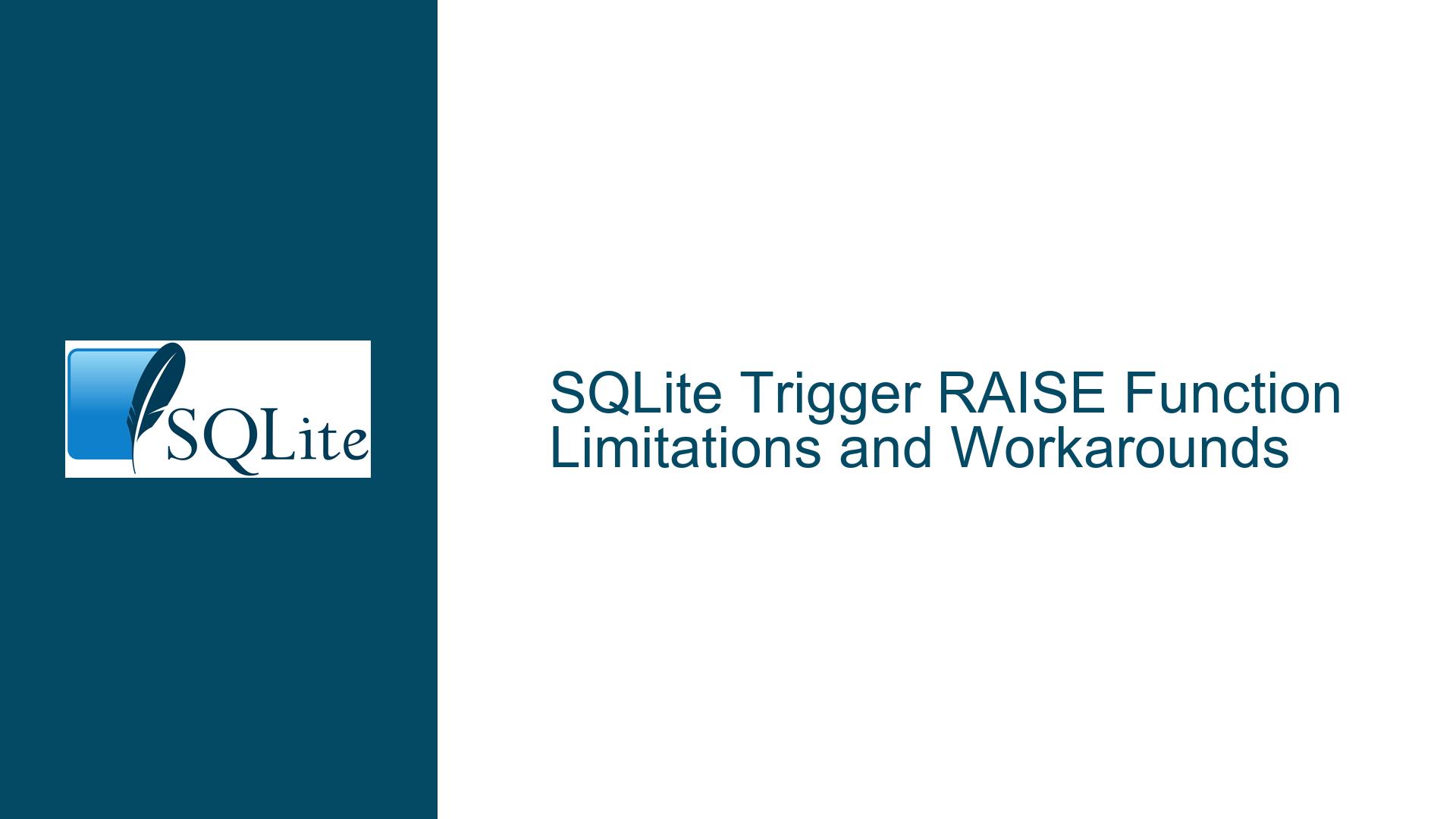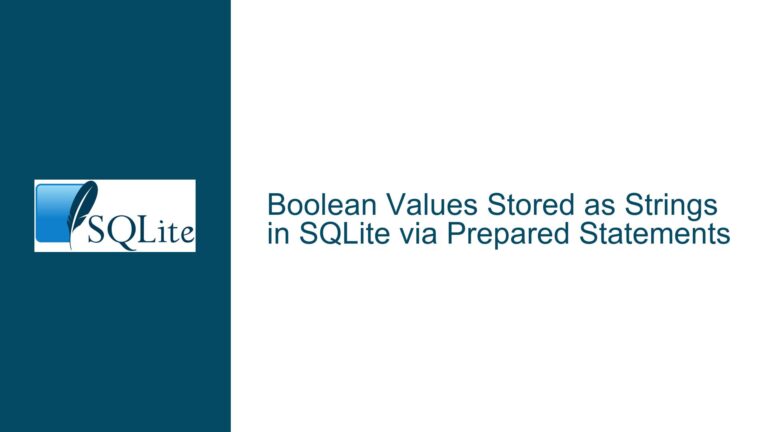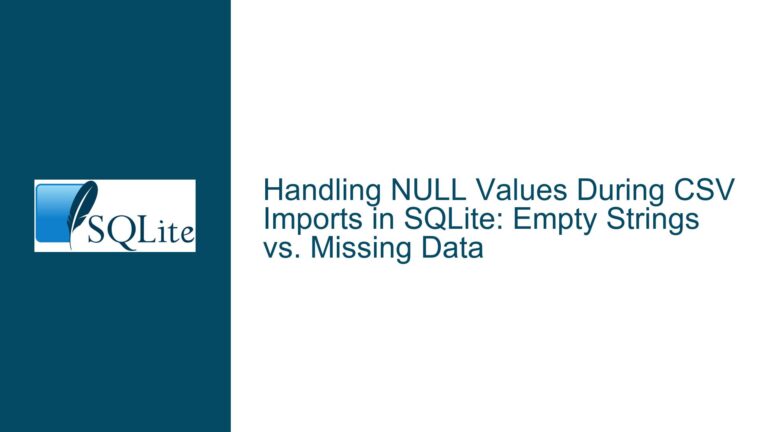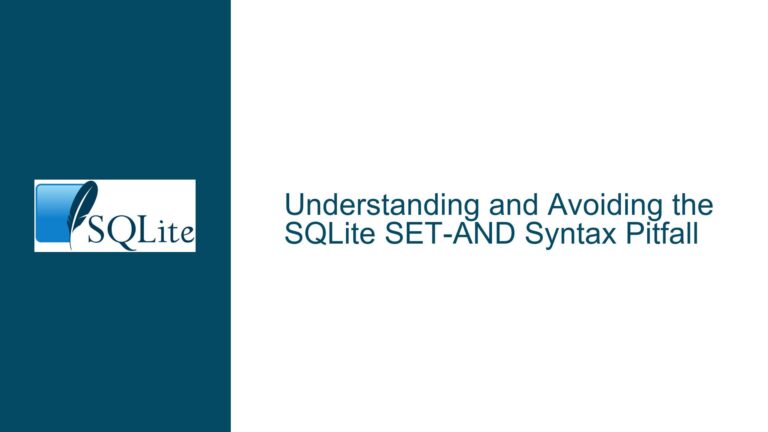SQLite Trigger RAISE Function Limitations and Workarounds
Issue Overview: RAISE Function in SQLite Triggers and Its Limitations
The core issue revolves around the use of the RAISE function within SQLite triggers, specifically in the context of BEFORE INSERT and BEFORE UPDATE triggers. The RAISE function is used to enforce data validation rules by aborting the operation and returning an error message if certain conditions are not met. However, the current implementation of the RAISE function in SQLite has a significant limitation: it does not allow for dynamic error messages that include references to table columns or expressions. This limitation becomes particularly problematic when developers need to provide detailed, context-specific error messages to end-users.
For example, consider a scenario where a trigger is designed to prevent a player from being assigned to multiple courts in the same tournament round. The ideal error message would include the player’s name and the court details, but the current RAISE function does not support such dynamic message construction. Instead, developers are forced to use static error messages, which are less informative and less user-friendly.
The discussion also highlights a related issue: the inability to create a single trigger that handles both BEFORE INSERT and BEFORE UPDATE events. In other databases, it is common to define a single trigger that applies to multiple events, but SQLite requires separate triggers for each event. This limitation adds complexity to the schema design and increases the potential for errors.
Possible Causes: Why RAISE Function Behaves This Way
The behavior of the RAISE function in SQLite can be attributed to several factors, both technical and design-related. First, the RAISE function is designed to accept a fixed string as its error message argument. This design choice simplifies the implementation and ensures that the function is lightweight, which aligns with SQLite’s overall philosophy of being a minimalistic and efficient database engine. However, this simplicity comes at the cost of flexibility, as it prevents developers from constructing error messages dynamically.
Another possible cause is the way SQLite handles expressions within the RAISE function. Unlike other SQL functions, which can accept complex expressions as arguments, the RAISE function is limited to a single string literal. This restriction is likely due to the way the function is parsed and executed within the SQLite engine. Allowing expressions would require additional parsing and evaluation logic, which could introduce complexity and potential performance overhead.
The discussion also touches on the historical context of this limitation. The RAISE function has been part of SQLite for many years, and its behavior has remained largely unchanged. While there have been requests to enhance the function to support dynamic error messages, these requests have not been prioritized by the SQLite development team. This could be due to a combination of technical challenges and the need to maintain backward compatibility with existing applications.
Troubleshooting Steps, Solutions & Fixes: Workarounds and Future Enhancements
Given the current limitations of the RAISE function, developers have several options for working around these issues. One common approach is to use static error messages that provide general information about the validation failure. While this approach is less informative, it is straightforward to implement and does not require any changes to the SQLite engine.
Another workaround is to use a combination of triggers and application-level logic to achieve the desired behavior. For example, instead of relying on the RAISE function to generate detailed error messages, developers can use triggers to set flags or store validation results in a temporary table. The application can then query this table to retrieve the necessary information and construct the error message dynamically. This approach requires more effort but provides greater flexibility and control over the error handling process.
For developers who need to support both BEFORE INSERT and BEFORE UPDATE events, the only option is to create separate triggers for each event. While this approach is less elegant, it is effective and ensures that the validation logic is applied consistently across all operations. Developers should carefully document these triggers to avoid confusion and ensure that any changes to the validation logic are applied to both triggers.
Looking ahead, there is hope that future versions of SQLite will address these limitations. The discussion mentions a recent check-in that introduces support for dynamic error messages in the RAISE function. This enhancement is currently on a branch and is expected to be included in SQLite 3.47.0. Once this feature is available, developers will be able to construct error messages using expressions and references to table columns, greatly improving the usability of the RAISE function.
In the meantime, developers can consider building SQLite from source and applying the relevant patches to gain access to these enhancements. This approach requires a higher level of technical expertise but allows developers to take advantage of the latest improvements without waiting for an official release.
In conclusion, while the current limitations of the RAISE function in SQLite can be frustrating, there are several workarounds available to address these issues. By understanding the underlying causes and exploring alternative approaches, developers can achieve the desired behavior and provide meaningful error messages to end-users. As SQLite continues to evolve, it is likely that these limitations will be addressed, further enhancing the flexibility and power of this widely-used database engine.






